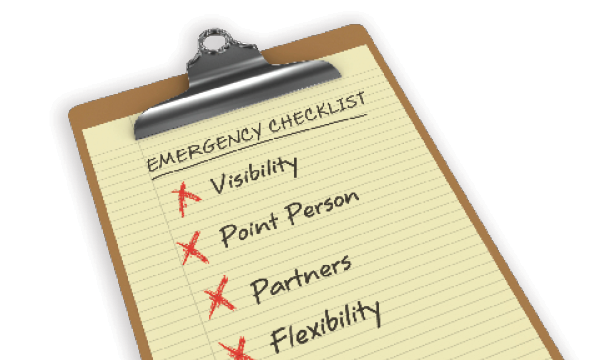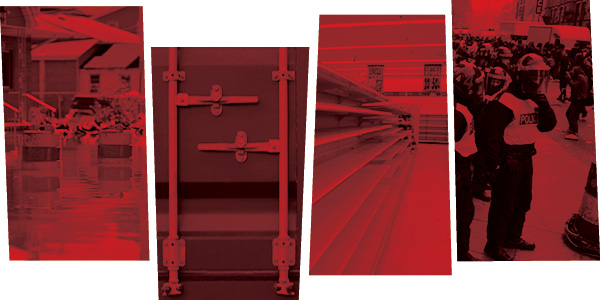Articles
Risk Management

Expecting the Unexpected: The True Test of Leadership
Regardless of whether you run a global organization or are just starting your logistics career, you already know that no two days in this business are ever alike. Every day is unique depending on what customers are being served, and where their goods are being shipped. Some days require more fortitude than others, however. Issues […]
Read More
Preparation: Your Best Asset in Managing Supply Chain Disruptions
Supply disruptions occur daily, caused by delayed deliveries; weather impacts on inbound supply; and prolonged standstills associated with natural disasters, port labor strikes, or critical supplier failures. Whatever the reason for the disruption, supply chain managers prove their value by delivering—no matter the circumstances. An active risk management process helps identify a range of possible […]
Read More
C-TPAT: Building Safer Supply Chains
The growing security concerns companies face in the global market make it critical to understand potential supply chain risks, and establish a managed, proactive approach to security. One significant step companies can take to protect their supply chains is becoming a member of the Customs Trade Partnership Against Terrorism (C-TPAT) program. As C-TPAT members, organizations […]
Read More
Shoring up Sourcing Strategies
Q: What factors are driving reshoring/near-sourcing consideration? A: A balance in labor rates between China and North America is warranting a second look at sourcing and manufacturing closer to demand. Mexico may be a first choice because of its labor cost differential, but the United States, with the promise of cheaper energy, presents another opportunity. […]
Read More
What Happens When Your Warehouse Is Unplugged?
In warehouses, business as usual relies on steady and stable conditions—but these are not guaranteed. Numerous situations can disrupt productivity: A hurricane or ice storm comes through and knocks the power out for several days. You outgrow your warehouse and have to shut down while you move to a larger facility. The server finally crashes, […]
Read More
Bringing Risk Management into the Heart of the Supply Chain
When supply chain executives are asked about the amount of contact they typically have with their chief risk officer, the answer is typically, "Not much." And they might add that their interaction usually involves providing input into enterprise risk management (ERM) for an update to their board. When asked whether the ERM team plays an […]
Read MoreMinimizing Supply Chain Risk
Lean concepts such as just-in-time, virtual inventory, supplier rationalization, and fewer distribution facilities reduce total supply chain costs. They also increase supply chain risk. Chris Cameron, solution architect at Exton, Pa.-based supply chain solutions provider Elemica, offers these tips for preventing supply chain disruptions. 1. Identify and assess current risk. Quantify and prioritize risk, then […]
Read More
Holiday Rush Planning: How to Mitigate Risk in a Volatile Market
In today’s globalized supply chain, extended manufacturing and transportation lead times dictate that retailers complete most holiday season planning in June and July. These plans are based on the best available intelligence at the time, including consumer forecasts, retailer promotions, and the competitive landscape. Within the build window for seasonal holiday demand, the industry is […]
Read More
How to Manage the Supply Chain Following a Natural Disaster
Planning for supply chain exceptions is increasingly an expectation for risk-sensitive shippers. The last decade has unleashed a flood of global weather disasters, from Hurricanes Sandy and Katrina to the eruption of Iceland’s Eyjafjallajokull volcano to the earthquake and tsunami in Japan. Each has impacted business operations in different ways. Failing to properly react to […]
Read More
How to Move Freight in Volatile Locations
Despite geopolitical upheaval, natural disasters, labor strife, war, and countless other disturbances that threaten supply chain efficiency and economy, freight still needs to move. From delivering humanitarian aid in hurricane-ravaged locations to managing mission-critical parts replenishment in remote areas and delivering heavy equipment in support of government operations, shippers need to be flexible and responsive […]
Read More
How to Mitigate Supply Chain Disruptions
As supply chains trend toward demand-driven, lean inventory models to eliminate waste, reduce costs, and increase responsiveness, their exposure to risk grows. When natural disasters, political upheaval, labor strife, supplier failures, and countless other types of supply chain events arise, shippers need to react quickly—without incurring undue costs—to keep production in line with demand. Companies […]
Read More
Mitigating Facilitation Risk
Facilitation is a unique risk for logistics professionals and companies. It is unlawful for logistics professionals or providers to facilitate transactions with any person or entity sanctioned by the U.S. government. The U.S. Justice Department has pursued facilitation cases against half a dozen logistics companies in recent months, and penalties include up to 10 years […]
Read More
Visibility is the Key to Mitigating Supply Chain Risk
As last year’s tsunami in Japan and massive floods in Thailand demonstrated, natural disasters and other events a world away can wreak havoc on supply chains, forcing sudden and major disruptions in business operations. While it may be impossible for a company to entirely escape the consequences of a widespread deluge, volcanic plume or labor […]
Read More
Can Your Global Supply Chain Withstand a Crisis?
Natural disasters, fluctuating oil prices, and other global factors continue to disrupt the flow of essential equipment and goods for manufacturers worldwide. For many companies, it has triggered a critical question: Can our organization’s supply chain withstand a major upheaval? It is an important question, because the flow of money through a supply channel determines […]
Read More
Beating the Odds in Latin America
Multinational corporations are gambling on the Latin American market’s growth potential. But when it comes to meeting the region’s supply chain challenges, all bets are off.
Read More
Managing Supply Chain Disruptions
These are challenging times for supply chain managers. During the past few years, a range of events and natural disasters has severely disrupted global supply chains, causing far-reaching effects across diverse geographies and markets. Yet today’s logistics landscape also holds huge potential for supply chain technology developments that help organizations better manage catastrophic events, as […]
Read More
Protecting Your Company Against Load Board Scams
Online load board scams have plagued the trucking industry for the past few years. Unfortunately, the lethargic economy means the problem will get worse before it gets better. Con artists are taking advantage of the fact that law enforcement has not made this issue a priority. Most scammers, in fact, are never prosecuted. On average, […]
Read More
Are You Effectively Managing Supply Chain Risk?
The events of Sept. 11, 2001, changed the way global businesses operate. The need for supply chain transparency has expanded beyond shipment tracking to include knowing trading partners’ background, the processes they handle, and the risk inherent at each stage of the supply chain from the factory floor to ultimate destination. Many regulations affect the […]
Read More
5 Steps to Improving Food Product Traceability
Food safety represents a pressing concern for consumers and food retailers. Several high-profile incidents have cost billions due to sickened consumers, lost sales, and contaminated products. If these occurrences have taught U.S. retailers anything, it’s that the ability to react swiftly and appropriately to food-related issues is essential. The passage of the U.S. Food and […]
Read More
Mitigating Supply Chain Risk
Today’s logistics and supply chain managers grapple with volatility, risk, and uncertainty. Learn what you can do to prepare for the unexpected.
Read More